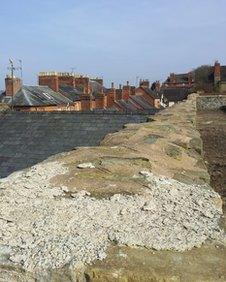Ludlow town walls collapse: Is time the biggest enemy?
- Published

Ludlow's town walls were built in the 13th Century as defence against attack from Welsh armies and two-thirds of them survive today
Ludlow's town walls were built to repel marauding Welsh armies but time and the elements have done more damage than any siege.
During February two sections of the wall collapsed into The Compasses Inn car park at Upper Linney.
More than 100 tons of sandbags have now been placed against the wall to prevent further damage.
The Ludlow Town Walls Trust, Shropshire Council and the Diocese of Hereford are all involved in deciding how to restore and preserve the 13th Century defences.
Colin Richards, Shropshire Council's historic environments manager, describes Ludlow as "one of Europe's premier fortified towns" because of the completeness of the walls.
"People can come to Ludlow and actually touch history - you can see building from the time of the conquest right up to the present day," he said.
He now faces the job of working out how to repair the section of wall that collapsed.
Gate tax
The walls were built around 1270, according to local historian Jonathan Wood, and about two thirds of them survive.
"The threat at the time was from the Welsh - the English had been defeated in 1066 at the Battle of Hastings but the Welsh held out for about 200 years" he said.
"The citizens of Ludlow decided they needed some protection and the irony was that in 1283 along came Edward I and conquered Wales."

More than 100 tons of sandbags have been used to stop further collapses into the pub car park
Mr Wood said Ludlow was a "plantation town" created by the Normans, who built the castle in about 1080.
The castle walls also helped the town to generate income, according to Mr Richards.
"Ludlow was a major trading centre, particularly during the period when it was making a lot of money from wool.
"With the seven gates that existed to get into the town, the town governors could impose a tax and they could gain revenue from the way the walls directed people through specific entry points," he said.
Lottery bid
Richard Cundall, chairman of the Ludlow Town Walls Trust, said one of the biggest problems with trying to maintain the 13th Century walls is "the huge diversity of ownership".

Houses have been built right up to the walls on both sides
The Diocese of Hereford will be involved in the repair work because the collapsed wall buttresses the churchyard of St Laurence's church.
Over time houses were built right up to the walls on both sides, which means there are 52 different owners of various sections.
"Private owners have done a lot of work, with the help of grants from English Heritage," Mr Cundall said.
Mr Richards knows from previous work he has undertaken that the repairs on the collapsed section will take "many months".
"Our experience of doing the car park wall was that it took the entirety of last summer.
"We started in March and we worked through until October and it will be a similar time scale for this," he predicted.
The Ludlow Town Walls Trust hopes something positive can come out of this latest collapse of the walls.
"What we need to do now is to use this crisis to generate some kind of long-term maintenance programme," Mr Cundall said.
The trust is submitting a bid for Lottery funding to help with the repairs.
- Published4 March 2013
- Published2 March 2013
- Published26 February 2013
- Published21 February 2013